Every Thursday morning between now and October, I will awake with a giddy sense of anticipation. I will check my email before I head into the office, hoping for a hint of what is to come. I will walk to work inhaling the morning air, which seems to have just a hint of something vegetal in its scent. I will struggle to focus on tasks for most of the morning, but will find myself daydreaming about mixing, frying, simmering.
You see, Thursday is when my CSA arrives.
Last August, I walked by a co-worker's desk to find an overflowing flat of the plumpest, most delicious-looking blueberries I had ever seen. When I asked her where they had come from, she told me she had recently joined a CSA (Community Supported Agriculture) with Viridian Farms. When I pressed for more information, she explained that membership had closed for the year, but (BUT!) she knew someone who had signed up for a share and no longer wanted it. What I did next probably violated the CSA code of ethics, but I'm thankful every day for this transgression: I impulsively emailed one of the farmers and let her know that a friend of mine had signed up for a share and would not be taking it - could I please, PLEASE (waitlist be damned) take her place?
The following week, P and I picked up our first box: peaches, blueberries, a simply enormous bag of tomatillos, asian pears, fava beans, pimentos de padron, and, and, and... We were floored. And thrilled. And most of all, grateful. A) This was some of the best, freshest produce we'd had, even from the farmers market and B) it was far more produce than we felt we had paid for.
Oftentimes when you pay in advance, you save money and a CSA is no exception. When you reserve a share you are committing to support the farmers upfront, during the time of year when they most need the money (spring can a be very difficult for farmers) and they're likely to thank you for it. Granted, CSA's vary in terms of the variety and quantity of produce you might receive, but in general when you buy directly from farmers and, in particular, when you pay in advance for a season of produce it means getting better products at better prices. Your savings probably won't compare with those you can get at a discount grocery, but for the security of knowing where your food comes from (salmonella scares, anyone?) and knowing that it's produced in a manner that is fair and sustainable, these prices can't be beat.
After our first week of gastronomic delights, the ten that followed (which, incidentally, were the same ten that led up to our wedding), were filled to the brim with incredible local, seasonal meals that were completely inspired by and utterly indebted to our CSA. Largely, P and I credit Viridian Farms with launching us whole-heartedly into home-cooking. We have always enjoyed cooking, but before Viridian was a part of our lives, weeks were structured around many nights of dried pasta with sauce and tacos, interspersed with more elaborate meals (mostly on weekend nightS). Being given an assortment of the freshest seasonal produce each week forced us to be creative with our cooking in a way that was utterly painless and infinitely exciting. This enthusiasm carried over to the remainder of the year, when we no longer had our CSA box coming but were so used to experimenting and cooking with whatever was freshest that we scoped out the best grocery stores and dedicated ourselves to market shopping in a way that we never had before.
Being a part of a CSA meant that last year we were able to visit the farm and pick flats of blueberries for $10 (in addition to the flat we got for free). It means that I know, intimately, where my food is coming from and that I have come to know and love the people who grow it. It means that I begin to know the history of the place in which my food is grown -
farmer Leslie's family has been farming for three generations and there is a rosebush on her property that used to be designated for corsages and now provides petals for rose butter and other delicacies. It means that I am becoming accustomed to the rhythms of this place. Our small apartment and tiny yard don't leave much room for the garden we wish for, but I feel in touch with the growing season through my CSA. When we've had a cold spring, like this one, I know that summer produce has been delayed, that summer squash and early summer beans are still a few weeks out. I know that during spring and early summer I will be receiving a slightly smaller box each week that will be offset by the full bounty of produce that will come later in the summer.
Given my eager countdown of the days until this summer's CSA start date (beginning from the last date of last year's share) and the excited conversations that P and I have, almost weekly, about our CSA, you may wonder why we've never written about this before. I wonder that myself quite a bit. Maybe it's because we were too busy writing about our wedding and by the time that whole (epic, beautiful) mess was over, so was our CSA. Or, because it became so much a part of our lives, that it seemed like our version of the grocery store (and who wants to hear about a trip to the grocery store?). Maybe we have come to love our CSA and our farmers so much, that we are a little afraid to write about it. We're too close to the subject.
Whatever the reason, here we are entering into another summer and our CSA is back, this time for 20 glorious weeks. Already, we have discovered new favorites like peach leaf ice cream (with an amazing, subtle almond flavor), rose petal and black pepper shortbread, and Puntarelle alla Romana (see cicoria catalogna puntarella a foglia stretta), and have relished in standard comforts like sage grilled cheese and fried egg sandwiches. Have I convinced you yet? Perhaps you might like to share in the bounty? Visit the Local Harvest website and find CSAs in your region. Peruse their offerings and try one out for a season. If you're worried about the amount of produce you might be given (sizes can vary and many are more suitable for families of four or more), find a friend to share the harvest. In the meantime, scope out your local farmers markets for tasty, seasonal produce from small family farmers. Then, throw yourself into cooking, because what else is so essential, so human, and yet so exciting? And finally, please, feel free to invite me over for dinner.
Have I convinced you yet? Perhaps you might like to share in the bounty? Visit the Local Harvest website and find CSAs in your region. Peruse their offerings and try one out for a season. If you're worried about the amount of produce you might be given (sizes can vary and many are more suitable for families of four or more), find a friend to share the harvest. In the meantime, scope out your local farmers markets for tasty, seasonal produce from small family farmers. Then, throw yourself into cooking, because what else is so essential, so human, and yet so exciting? And finally, please, feel free to invite me over for dinner.
-----------------------------------------------------------------
Fried egg and sage grilled cheese sandwiches (serves 2)
(We made these sandwiches the night of our first box of the year. We were too tired to cook an elaborate meal and had received a huge container of sage, so this twist on the classic grilled cheese sandwich fit the bill)
2 eggs (preferably farm fresh - during this time of year, there are usually plenty of vendors selling eggs at your local farmers market)
Handful of fresh sage
Small block of cheddar (we used Beecher's Flagship, but any will do)
4 slices of bread
Butter
Fry the sage leaves in a nob of butter until they start to turn brown and crispy and give off a pleasant, nutty aroma. Remove from heat and reserve. Butter the undersides of the bread, then place a layer of cheese on the unbuttered side, make a sandwich and put this into a pan to cook over medium heat. Fry on one side until the bread is golden brown and the cheese has begun to melt, then flip and repeat. While the sandwich is grilling, fry one egg (you can keep the yolk, but it might get extra messy - we like to smash ours). When both sides are browned and the cheese is nice and melty, remove from the pan, open the sandwich and place the egg on top of the cheese. Then place a layer of the crispy sage, top off the sandwich and enjoy!
Monday, June 23, 2008
farm fresh
Posted by
a
at
9:30 PM
1 comments
![]()
Tuesday, June 10, 2008
black & tan & black & tan & ...
Listen, Deschutes: it didn't have to be this way. You could have had all the glory for yourself. But you had to go and get all "technical" with me when I asked for a black & tan. Yeah, your brewmasters might have their hang-ups about liquid densities and the feasibility of layering a Mirror Pond Pale and an Obsidian Stout, but I just wanted a beer; not a science lesson. That means that you drove me to this. You made me take this folly on at home where it became even more likely that I'd make a mess out of trying to layer your booze in a pint glass. I still wanted a black & tan better than some old Guinness & Harp; I wanted a domestic black & tan to be proud of.
So, Deschutes, last weekend I pitted the black & tan you wouldn't make for me up against two other West coast breweries in a battle royale of mixed beers. I dragged A along to Belmont Station to select the contenders (though, I suppose it isn't so much dragging when she could easily spend as much time browsing their British food as I could their bomber selection) . I already had Deschutes in the first slot and figured that two other breweries would be enough for comparison without laying us both out in the process. The second brewery was an easy choice as well: Anderson Valley, which has to be one of my favorite breweries in the country, happens to make both an excellent stout and a great amber. That left the third glass empty. When we asked one of the staff if he had any ideas, he scoffed at the idea of a black & tan and said that if we were mixing beers, we'd be better off going for interesting flavors. That led us to North Coast Brewing, from which we selected two high-ABV beers bound to create a strange brew.
How it went down:
First of all, pouring a black & tan is a lot harder than it seems. You fill your pint glass halfway with an ale, then slowly pour the stout over the back of a spoon so that it doesn't break the surface, but just lies on top as a distinct layer. Ha. So maybe Deschutes was correct and the densities of American beers are just too hard to layer. Or maybe it has something to do with the American spirit that blends diversity into a cohesive whole or some b.s. like that. In any case, I ended up with some dark, blended pints instead of pretty pousse-cafe beers. Round One: I kicked things off with the Deschutes, giving them the benefit of starting off on a fresh palate. On its own, the Mirror Pond Pale Ale is medium-bodied and very wheat-y. It has a taste of untoasted bread and a big, hoppy punch for a pale. When you take a whiff of the Obsidian Stout, you get a really strong coffee aroma, but the flavor is all roasted nuts and seeds. The Obsidian, too, was fairly hoppy for its class, which just cements my belief that Portland breweries love making hop-bombs.
Round One: I kicked things off with the Deschutes, giving them the benefit of starting off on a fresh palate. On its own, the Mirror Pond Pale Ale is medium-bodied and very wheat-y. It has a taste of untoasted bread and a big, hoppy punch for a pale. When you take a whiff of the Obsidian Stout, you get a really strong coffee aroma, but the flavor is all roasted nuts and seeds. The Obsidian, too, was fairly hoppy for its class, which just cements my belief that Portland breweries love making hop-bombs.
Mirror Pond + Obsidian = The M.O.
When I blended the two Deschutes' brews, I have to say it kind of improved on the harsher aspects of both beers. The coffee tones of the Obsidian were bumped way up and sharpened with the Mirror Pond's acidity, to give it the character of an African coffee. Round Two: These might be two of my favorite beers on their own. While I love the Portland hop-addiction, Anderson Valley makes really well-balanced, smooth beers that belie their complexity. The Boont Amber Ale is very malty and has a much rounder flavor than the Mirror Pond. As for the Oatmeal Stout, it leans much more towards the chocolate end of the stout spectrum, reminding me of Hershey's syrup with a caramelly richness.
Round Two: These might be two of my favorite beers on their own. While I love the Portland hop-addiction, Anderson Valley makes really well-balanced, smooth beers that belie their complexity. The Boont Amber Ale is very malty and has a much rounder flavor than the Mirror Pond. As for the Oatmeal Stout, it leans much more towards the chocolate end of the stout spectrum, reminding me of Hershey's syrup with a caramelly richness.
Amber Ale + Oatmeal Stout = Amber Waves of Grain
Blending these two didn't noticeably improve upon either of the beers, perhaps because they were so good to begin with. Taken together, it was a very full bodied drink and nicely balanced. In a lot of ways, it had a bourbon-like flavor. Round Three: At this point, A and I were both pretty glad that I'd gone for the 12 oz. bottles, rather than the 22 oz. bombers I'd wanted to get. Judging was certainly getting more difficult and well, you can just forget about my "layering" craft. Our choices from North Coast weren't going to make this any easier - we'd selected two strange, strong beers. For our "light" beer, we chose the Pranqster Belgian-style ale, a yeasty, heavy, ripe-tasting brew. To balance it, we went for an equally imposing stout, the Old Rasputin Russian Imperial. On its own, this stout has a funky sweetness like burnt sugar, and an alcoholic edge with a lightly smokey flavor.
Round Three: At this point, A and I were both pretty glad that I'd gone for the 12 oz. bottles, rather than the 22 oz. bombers I'd wanted to get. Judging was certainly getting more difficult and well, you can just forget about my "layering" craft. Our choices from North Coast weren't going to make this any easier - we'd selected two strange, strong beers. For our "light" beer, we chose the Pranqster Belgian-style ale, a yeasty, heavy, ripe-tasting brew. To balance it, we went for an equally imposing stout, the Old Rasputin Russian Imperial. On its own, this stout has a funky sweetness like burnt sugar, and an alcoholic edge with a lightly smokey flavor.
Pranqster + Old Rasputin = Old Russian Joke
This was the wild-card blend of the night. It ended up tasting a lot like a barleywine - it had that classic sweetness with a hot, alcoholic kick. Our last black & tan ended up being the weirdest of the bunch, but it had its own, heady appeal.
Lessons learned? I'm still not going to listen to the pros, but I may need to practice pouring a black & tan sometime when I'm not drinking a black & tan. The two do not mix well, but the beers certainly do.
Posted by
p
at
8:30 PM
4
comments
![]()



